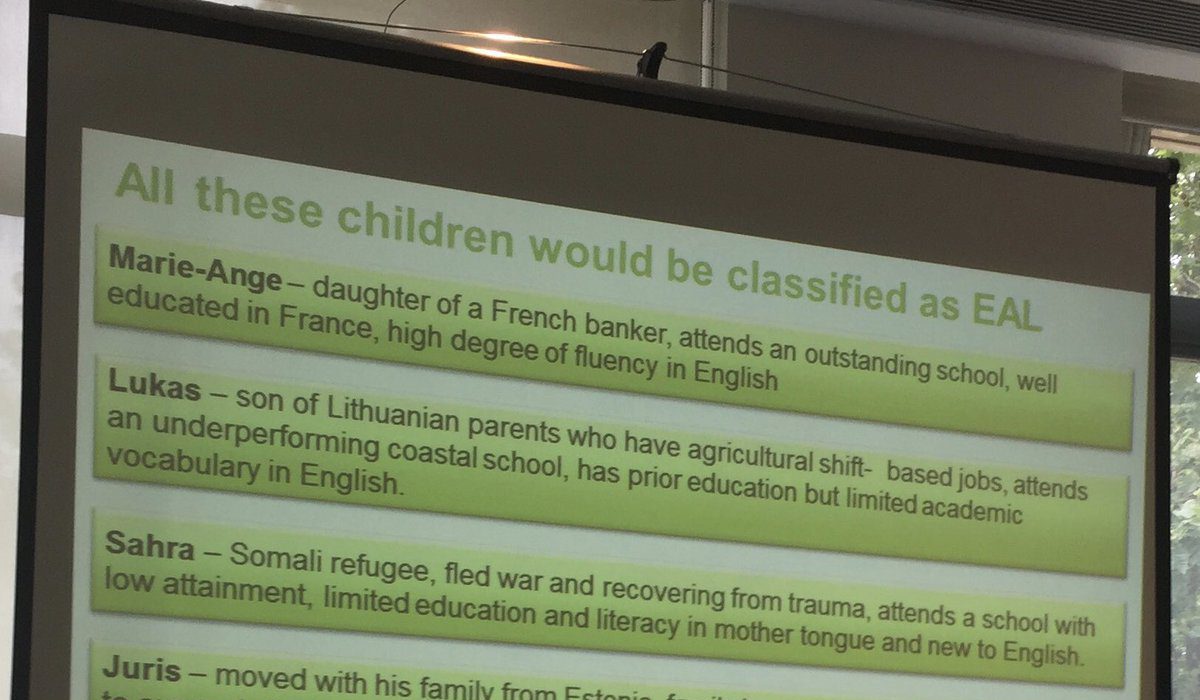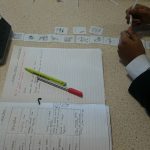Linda Sandler is Head of EAL at Falinge Park High School in Rochdale, where seventy-eight per cent of the pupils are bilingual. In this post she describes partnership teaching and offers a vignette based on her own experience of how it can work in practice.
In a time of great turmoil and shrinking budgets, partnership teaching is an efficient and effective use of the expertise of EAL practitioners. It can include a range of activities:
- Working collaboratively with subject teachers in ‘mainstream’ classrooms to meet the needs of EAL learners.
- A plan–do–review action research cycle.
- A partnership of experts – one in a subject and the other in EAL teaching.
- A partnership that recognises the distinctiveness of EAL.
- The teacher as researcher.
- A whole–school approach to meeting the needs of EAL pupils.
- Constructing a compelling learning experience.
Partnership teaching works through conversations about language and learning in the context of the curriculum. The conversations amalgamate perspectives about content and language which can generate resources and activities where the structure of the content and of the language reflect each other.
Before lessons, effective teaching partnerships will include:
- Analysing the language demands of the curriculum in the context of real lessons.
- Planning to ensure a language focus in the classroom.
- Providing ideas and designing differentiated resources.
- Ensuring that language inputs will take place.
- Ensuring there will be active language use in the lesson.
- Supporting the development of bilingualism through planning opportunities for pupils to use and develop all their language resources.
- Creating a classroom environment that facilitates language development, including seating plans and grouping of pupils, normalising ‘thinking time’.
A vignette
The way in which energy is conceptualised in the science curriculum has changed recently. The purpose of the change is to make the school curriculum fit in better with scientific understandings of energy. Instead of talking about forms of energy, now we talk about energy stores and how they are transferred.
| Energy Stores | Energy Pathways |
| Electric and magnetic | Electrical |
| Chemical | Mechanical |
| Gravitational | Heating by particle movement |
| Kinetic | Heating by radiation |
| Thermal | |
| Elastic | |
| Vibration | |
| Nuclear |
A Science teacher and an EAL teacher sit down together to work out a lesson on energy transfers. They start by talking to understand how energy transfers now need to be taught which is quite different from how it was taught in the past. Their conversation has all the features of the kind of task-focused talk that we want learners to use. The purpose is to understand changed ideas and how to enable learners to acquire the language they need in order to clarify and to show their own understanding of these ideas.
The conversation goes something like this:
The Science teacher explains his understanding of the new model. The EAL teacher reframes the explanation to test his own understanding – “Do you mean…?”; “Have I got this right?”; “So a hot cup of tea has a store of thermal energy?” The Science teacher re-explains in the light of the EAL teacher’s explanation of his own understanding in order to make it clearer to the EAL teacher.
The two teachers look at some visuals provided by the examination board in order to begin to frame what the lesson will look like.
The EAL teacher asks “What’s happening here?”; “What’s the energy transfer?”
It becomes clear that they need to separate the situation in which the energy transfer takes place from what energy stores there are and how they are transferred.
The Science teacher begins to generate some sentences. The EAL teacher realises that there are two different types of sentence. Together, they refine the two types of sentence to get model sentences with clear language patterns:
“A tram moving along a track”
“An electrostatic energy store is transferred into a kinetic energy store”
The EAL teacher uses this forum to draw out the grammatical features of the two types of sentence and to make the point that learners will be able to see the patterns of the language in the context of the content. This will allow them to understand the ideas and to acquire the grammatical features they are ready to acquire.
During lessons, the EAL practitioner might:
- Use and model a range of language development techniques.
- Support the subject teacher in trying out these techniques.
- Jointly present the lesson or lead the lesson.
- Share responsibility for the progress of pupils, including both early stage and more advanced EAL learners.
- Work with individuals and groups for a specific purpose.
- Engage in formative assessment of language development and learning in order to provide feedback and to inform future planning.
- Support risk-taking, such as trying out challenging teaching and learning strategies.
After lessons, good partnership practice is to:
- Evaluate the lesson’s intended and actual outcomes to inform planning
- Use any formative assessment to inform planning
- Evaluate any new resources or teaching and learning strategies used and decide how these should be shared if needed
- Discuss the linguistic and learning progress of particular individuals
- Plan the next lesson
Using partnership teaching
There are a number of reasons why we have adopted and developed this model at Falinge Park High School and have found it to be highly successful.
The model provides pupils with the opportunities to learn language through and for learning in contexts that provide linguistic models, motivation and engagement. Pupils develop both academic and social language meaningfully. Relationships between pupils are harmonious and very supportive so early-stage learners can quickly become more independent. It ensures that the whole school becomes EAL pupil-friendly so early stage learners are not the sole responsibility of the EAL faculty or segregated from the rich linguistic resources within the school community.
Collaborative planning is creative planning and builds good working relationships. It can transcend perceived differences in status in the classroom. It is an excellent way of delivering one-to-one, bespoke CPD with built-in coaching, supported by the joint delivery of lessons in the classroom. Teachers use new techniques and resources with other classes so it maximises the reach of the support provided by the EAL faculty. We can focus on more-advanced EAL learners as well as early-stage learners. In Cummins’s terms, it establishes optimum conditions for developing both Basic Interpersonal Communication Skills (BICS) and Cognitive and Academic Language Proficiency (CALP). Moreover, it is an exciting and rewarding way of working for both partners.
The model ensures that the EAL team is up to date with syllabuses and schemes of work and that the profile of our work is raised so that we are naturally involved in shaping the direction of whole school priorities and development planning, particularly with regard to Learning and Teaching.
“You get another perspective when you plan together.”
We would emphasise that this way of working has been developed and embedded at Falinge Park over many years. Subject staff have made some perceptive comments about why it works. One Science teacher said “…you get another perspective when you plan together”. Another, that “I want to know more about EAL teaching because I think it gives you a better understanding of more inclusive classroom practice. A little tweak or twist can bring a whole new dimension that is far better for EAL learners.”
The partnership model has also allowed us the flexibility to support members of staff who are new to teaching or who have previously been in schools with few EAL learners. One teacher who was an NQT last year said, “It’s been really beneficial to work with someone knowledgeable about EAL. I really enjoyed planning lessons together. It was a chance to experiment, take risks and see what works.”
The last word goes to the pupils themselves. Pupil A (2 years UK schooling, from Iraq, young carer. Year 10):
“I prefer to be with all the other students in the classroom because when I listen and I don’t understand, they will explain. Also I like my lessons.”
Pupil B (4 years UK schooling, from Guinea Bissau. Year 11):
“It was scary at first. I felt more comfortable when a teacher (EAL) came and sat with me. I was looking at the door to see if someone would come. All the (subject) teachers were really nice but they need to know a bit more about how to help you.
“I liked learning the language and the subject at the same time. You learn really quickly. I started in February and by the end of year 7 I was speaking English. I was nervous about getting it wrong at first but when my teacher praised me for being the only person to get a question right in my Spanish lesson (it was a question in English) and said that everyone else should have got it because I had only been learning English for a little while, I decided to start speaking English. One time I got the highest mark in my English lesson – I went from a 1c to 3c by the end of year 7.”
So please try it out. Start with where you will think it will be most successful and implement a ‘pilot project’ that you can evaluate – working with new teachers can be successful. Think long-term and give it a chance to impact on learning; it needs time – it’s deep learning. Anything that goes wrong is an opportunity to learn so don’t get discouraged and remember, you are equal partners and you both have your specialisms to bring to bear on ensuring bilingual learners make the progress and have the success they deserve.
With many thanks to Mary Coates, Ian Jones and the staff of Falinge Park High School.

The EAL Journal is published termly by NALDIC, the subject association for EAL. Visit www.naldic.org.uk to become a member.




